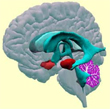Tuesday, 27 January 2015
Functions of the amygdala : more diverse than previously thought

Science in general, and neuroscience in particular, are constantly evolving. So even though our knowledge of a given brain structure may not have undergone a scientific revolution or a paradigm shift at any given time, when we compare what we know about it now with what we knew, say, 10 years ago, we may find that things have changed a lot. That’s certainly the case for the amygdala, a small but very important piece of the brain. And since we first described the amygdala on this website just about 10 years ago, we’d like to give you a little update now.
The amygdala is roughly the size and shape of an almond and has traditionally been portrayed as the brain’s “alarm system”. Indeed, the earliest studies on the amygdala, done using rats, clearly demonstrated that this structure is strongly activated when an animal is afraid of a danger.
The work of Joseph LeDoux in particular contributed to the identification of two pathways of fear: a “short route” that activates the amygdalic alarm system immediately when a threatening stimulus is first perceived, and a “long route” that, a few fractions of a second later, activates the cortex and other brain structures that pay attention to the threat and more finely discriminate its nature.
Over the years, however, studies by several research teams have suggested that it may be simplistic to regard the amygdala’s role as solely fear-related. In his book The Cognitive-Emotional Brain: From Interactions to Integration, Luiz Pessoa provides a far richer and more complex view not only of the amygdala, but also of the relationship between cognition and emotion.
In fact, the idea that the amygdala plays a broader role than that of the “fear centre” so often portrayed in the media has been around since at least the 1970s, when Karl Pribram and his colleagues wrote that the amygdala lets us not only know what is out there in our immediate environment, but also determine what we are going to do about it once we know. More recently, these ideas have been taken up by William A. Cunningham, who sees the amygdala as dealing with everything that concerns us, and not only as detecting threats.
Pessoa confirms the amygdala’s function of determining what “survival value” a stimulus has for the organism. But he also stresses that, contrary to common belief, this value may just as easily be positive as negative. Though the amygdala is relatively small, it is composed of several nuclei (sub-regions) that, neuroscientists have begun to realize, contribute to various aspects of its possible responses to stimuli. For example, some of these nuclei appear to be activated when the individual recognizes a stimulus that has been associated with a reward in the past.
The functions of the amygdala are now recognized to include alertness and novelty detection—in other words, overall attention to the world around us, which, together with the function of assigning survival value, points to involvement in certain simple forms of decision-making. Not making the kind of decisions that, say, a mathematician does when trying to prove a theorem, but the simple kinds of decisions that we all make many times each day, such as the decision to approach or avoid certain things, or certain people.
This broader conception of the role of the amygdala also raises questions about the standard “two-route” hypothesis. Why? Because traditionally, the subcortical short route associated with quick emotional reactions was assumed to be independent of the attention paid to a stimulus. Pessoa, however, presents data showing that, on the contrary, the attention that individuals pay to stimuli determines what information does and does not enter the amygdala. He also shows that not everything that happens in the cortex is slow and laborious, and that rapid signalling can take place within the cortex too.
In light of all these new findings, how can we attribute any particular function to the amygdala? Pessoa’s answer is that we simply can’t. His position is still somewhat controversial, but the wealth of interconnections that the amygdala has been found to have with other brain regions increasingly suggests that its numerous functions emerge from its interactions with those regions. Thus the unit of interest for brain functions is more and more the interaction, rather than location in the strict sense. As we said at the beginning of this post, science is constantly evolving.
![]() “The Cognitive-Emotional Brain” (BSP 106)
“The Cognitive-Emotional Brain” (BSP 106)
![]() The Cognitive-Emotional Brain
The Cognitive-Emotional Brain
Emotions and the Brain | 1 comment








Interesting…our emotions then, such as fury and mental fear, are a direct result of fear itself? How then can our anger be attributed to a strong will? So the defiance and rebellion of teenagers is actually a fear of being unwanted or useless. Or maybe something deeper… like I said, interesting!